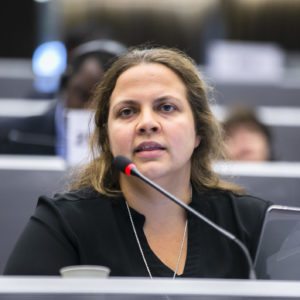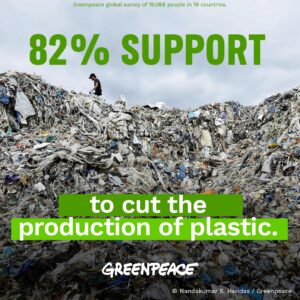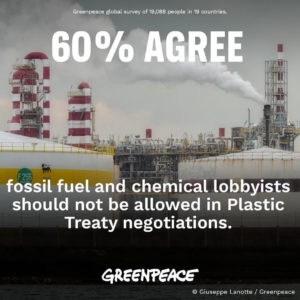Event Virtual
Plastic Production: Latest Views from Scientists and the Public

This event, co-organized with Greenpeace, within the framework of the Geneva Beat Plastic Pollution Dialogues, stressed the importance of globally-binding obligations to reduce plastic production.

About this Event
Many expert studies continue to be carried out by different bodies to highlight the need for the reduction of plastic production, with a particular focus on the greenhouse gas emissions from plastic production as a clear metric to show that we need to reduce production volumes.
In preparation for the next round of negotiations on a legally-binding instrument on plastic pollution, to take place in Ottawa, Canada in April, this event will stress the importance of globally-binding obligations to reduce plastic production.
At this event, Greenpeace will present its newly commissioned global public opinion polling in 19 countries about supporting a strong and ambitious Global Plastics Treaty (GPT) focusing on key questions, including reducing plastic production in line with 1.5°. Other experts presented other perspectives and data on why production reduction is important, including biodiversity and human health impacts.
Geneva Beat Plastic Pollution Dialogues

The world is facing a plastic crisis, the status quo is not an option. Plastic pollution is a serious issue of global concern which requires an urgent and international response involving all relevant actors at different levels. Many initiatives, projects and governance responses and options have been developed to tackle this major environmental problem, but we are still unable to cope with the amount of plastic we generate. In addition, there is a lack of coordination which can better lead to a more effective and efficient response.
Various actors in Geneva are engaged in rethinking the way we manufacture, use, trade and manage plastics. The Geneva Beat Plastic Pollution Dialogues aim at outreaching and creating synergies among these actors, highlighting efforts made by intergovernmental organizations, governments, businesses, the scientific community, civil society and individuals in the hope of informing and creating synergies and coordinated actions. The dialogues highlight what the different stakeholders in Geneva and beyond have achieved at all levels, and present the latest research and governance options.
Following the landmark resolution adopted at UNEA-5 to end plastic pollution and building on the outcomes of the first two series, the third series of dialogues will encourage increased engagement of the Geneva community with future negotiations on the matter.
Speakers

Juliet KABERA
Director General, Rwanda Environment Management Authority

Louise ROUSSEAU
Head, Water, Pollution and Transversal Affairs Division, French Ministry for Europe and Foreign Affairs

Valentina SIERRA
Permanent Mission of Uruguay to the United Nations in Geneva

Dennis CLARE
Delegation of the Federated States of Micronesia to the Intergovernmental Negotiating Committee on Plastic Pollution

Bethanie Carney ALMROTH
Professor at Gothenburg University | Scientists’ Coalition for an Effective Plastics Treaty

Winnie LAU
Project Director, Preventing Ocean Plastics, The Pew Charitable Trusts

Ieva RUCEVSKA
Senior Expert, GRID-Arendal

Rayhan DUDAYEV
Senior Regional Campaign Strategist (Legal and Political), Greenpeace Southeast Asia

Daniela DURAN
Senior Legal Campaigner, Upstream Plastics Treaty, Center for International Environmental Law (CIEL)

Melissa WANG
Senior Scientist, Greenpeace International and Honorary University Fellow, University of Exeter | Moderator
Summary
Key Takeaways
- Plastic pollution is an incredibly complex global problem that risks human health, environmental damage, climate change and biodiversity loss
- Strong binding provisions on plastic production reduction are crucial for an effective Global Plastics Treaty – this reflects both the scientific consensus and public opinion
- Human rights, just transition and waste pickers must not be forgotten during the negotiating process
Opening Remarks
Addressing the question of why plastic production reduction is important for their country or region, and any key messages to share ahead of INC4.
Juliet KABERA | Director General, Rwanda Environment Management Authority
- Rwanda joined forces with Peru to spearhead the resolution to create a global legally binding treaty to end plastic pollution. The full lifecycle of plastic must be considered, stressing the reduction in plastic production.
We cannot solve the plastic pollution crisis without reducing plastic production.
- Rwanda, amongst other high-ambition coalition countries, are calling for binding provisions to reduce the production and consumption of primary plastic polymers to sustainable levels.
Louise ROUSSEAU | Head, Water, Pollution and Transversal Affairs Division, French Ministry for Europe and Foreign Affairs
- France is a member of the High-Ambition Coalition and calls for a reduction in plastic production.
- France concurs that the full lifecycle of plastics must be addressed to end plastic pollution.
Pollution starts as soon as production
- It is of major importance to create discussion spaces between countries, scientists and the general public that unpacks the science into digestible comprehension. It is very clear that science must be listened to, and thereby science informs the decision making process. Countries that are decision makers, will be able to make better informed and stronger decisions when backed up with science.
Valentina SIERRA | Permanent Mission of Uruguay to the United Nations in Geneva
- Uruguay believe to achieve the goal to end plastic pollution by 2040 is by adopting strong global obligations based on a comprehensive approach that would address the full life cycle of plastics and promote their sustainable production and consumption.
- It is imperative that the treaty includes a human rights approach that takes into account groups in vulnerable situations, including workers and informal workers, especially waste pickers and they must be included in the treaty process.
- Moreover, a focus on the protection of human health and the environment is imperative.
The plastic treaty MUST include obligations for reducing the production of primary plastic polymers. The science is clear: more production means more pollution.
- The instrument must severely restrict the production and use of specific polymers, chemicals and plastic products that are harmful to the environment and human health.
- A non-toxic circular economy begins with the design of products that reduces material input, avoids the use of toxic chemicals, and enables reuse and recycling. To achieve this, access to information, transparency and traceability will be key. At the same time, it must be ensured that a potential replacement of polymers, chemicals and plastic products, by other alternatives and substitutes, will not lead to any comparable kind of harm or negative impact. And that they will be affordable and accessible to developing countries.
Dennis CLARE | Delegation of the Federated States of Micronesia to the Intergovernmental Negotiating Committee on Plastic Pollution
- There is a striking similarity between the hydrofluorocarbon (HFC) phase-out to the plastic crisis. Just like HFCs, if plastic production isn’t limited, our climate goals become impossible to achieve.
Small island states, as well as African states and Latin American states play an important leadership role in this treaty, especially calling for production limits, regulation of harmful chemicals and for robust finance mechanisms.
- Member states must live up to the agreed mandate to address the full lifecycle of plastic pollution, which automatically includes plastic production as well as harmful chemicals, in order to protect human and environmental health. Redesign, longevity, recyclability as well as waste management is part of the lifecycle too.
- Unsustainable overproduction is the root cause of the plastic production & pollution crisis.
- Equity and fairness must be ensured as we come together to negotiate this instrument. Small islands are not to bear the financial and resource brunt of this crisis. There must be balance between countries in order to ensure an equitable approach. Those countries with the most resources cannot shift the burden downstream. The treaty should provide relief to island states.
Panel Discussion
Primary Plastic Polymers: Urgently Needed Upstream Reduction
Bethanie Carney ALMROTH | Professor, Gothenburg University | Scientists’ Coalition for an Effective Plastics Treaty
- The Scientist’s Coalition comprises scientists standing on decades of evidence on where we are in understanding pollution and plastics as a material
- The future of humanity depends on ambitious, legally-binding global and national plastic production reduction targets
What are primary plastic polymers?
- This is a dense definition but to pick up on a few points:
- Referring to synthetic and semi-synthetic
- Including bio-based feedstocks which we think need to be addressed throughout the treaty
- Not just materials, not just polymers- they contain up to 16,000 chemicals that are hazardous, persistent and cumulative (The PlastChem report “State of the science on plastic chemicals. Identifying and addressing chemicals and polymers of concern”
- Compounding factors include:
- Plastic value chains are very complex- 1400 kinds of products include plastics, markets are plagued by low-transparency and knowledge gaps
- Oil and gas subsidies keep the price of plastics low, externalities are paid for outside of companies producing them
- Low recycling of single-use and short-lived plastics
- Downstream responses become more complex and expensive
- Downstream action alone will not solve the plastics crisis. We must include upstream measures starting with production. → Read more on the Scientists’ Coalition’s publication Primary Plastic Polymers: Urgently needed upstream reduction
- We’re not asking to stop all production- plastics can be deemed essential materials with essential uses, but we need to address hazardous and unsustainable plastics
- Pollution is occurring at every stage, from transportation onwards (e.g. the East Palestine train derailment) including greenhouse gas emissions across the entire life-cycle
- We have even found plastics in human bodies in blood, various tissues, placenta, more recently in plaques in arteries, and there is emerging evidence of correlations between micro/nanoplastic exposure and adverse health outcomes
- There is a substantial body of evidence that chemicals in plastic are having human health effects including hormone disruption, nervous system damage, cardiovascular damage etc.
- We’re starting to see evidence of plastics’ effect on the triple planetary crisis

- Even if we reduced by 1-3% per year we will still see pollution increase as cumulative production- we need more ambitious reduction targets than this
- The Scientists Coalition is asking for:

Ending Plastic Pollution by 2040: The Need for a Full-Life Cycle Approach
Winnie LAU | Project Director, Preventing Ocean Plastics, The Pew Charitable Trusts
- All reports and analyses show a consensus that business-as-usual (BAU) will lead to unsustainable growth in plastic production and pollution.
- According to the Nordic Council of Ministers, under BAU scenario, annual production of virgin plastic will increase by 66% to 712 MT by 2040 severely impacting human health, livelihoods, and natural ecosystems. The associated GHG emissions will also increase.
- There is hope and there are pathways for us to end plastic pollution but requires action across the full life cycle of plastics (upstream, midstream and downstream).
- The Pew and partner’s research found out that actions upstream has the biggest impact on plastic pollution and GHG emissions. There is potential to reduce plastic pollution by different actions under a systems change scenario. Reducing (elimination, reuse, refill systems, redesign) leads to the biggest reduction and the biggest opportunity – nearly ⅓ among all the actions. Strategies focused on downstream actions without upstream measures would still result in 18MT of plastics flowing into the oceans by 2040. →Read more on Breaking the Plastic Wave
- Research also showed that demand reduction isn’t sufficient. There are provisions in the draft text of the treaty that focus on avoidable and problematic plastics and product design that can reduce demand for plastics, but on their own, they are unlikely to reduce plastics pollution by 2040. Even if all countries implemented the EU approach, plastic leakage would only reduce 15% from BAU.
- Microplastics are released throughout the lifecycle. Pew has done research on microplastics and nanoplastics during recycling and it is a pervasive problem. They are released from the very beginning of the plastics lifecycle in the form of plastic pellets.
- Simply managing plastics at the end of their lifecycle through recycling and disposal will not be enough. An instrument that mainly focuses on downstream solutions without meaningfully reducing production levels will not successfully meet its objectives.
Global Actions Through the Plastic Life Cycle
Ieva RUCEVSKA | Senior Officer, GRID-Arendal
- GRID-Arendal has recently published the report Climate Impacts of Plastics which examined latest scientific findings regarding GHS emissions across the different stages of the plastics lifecycle, and looked at the current plastics-climate reporting efforts particularly UNFCCC and the Paris Agreement. The report also identified options for measures to maximize the climate benefits through the global plastic instrument.
- There is sufficient scientific evidence on the impacts of plastics and there is GHG emissions throughout the lifecycle of plastics collectively estimated to be about 2 gigatons of CO2 emissions equivalent representing 4% of global emissions. Plastic production being a high energy demanding process is responsible for the highest amount of emissions at 85%. Waste management emissions (recycling, incineration, landfilling) account for 6% of plastics-related GHGs. The total amount is likely to be higher because it does not include emissions from plastic use stages. Unintended losses and leaks of methane during raw materials sourcing are not included in the estimates. There is still a knowledge gap about emissions from open burning of plastic waste
- Plastic production is an energy-intensive process. GRID-Arendal attempted to distinguish between emissions that are directly attributed to the sourcing of raw materials and plastic production and manufacturing and those attributed indirectly. Plastic production involves refining, cracking, polymerization and conversion processes. Direct emissions account for less than half of total emissions at 41%. Indirect emissions of plastic production manufacturing are more significant than direct emissions. Indirect emissions arise from electricity generation, transport, fossil fuel extraction, and other sectors. Electricity generation is often coal-based. This differentiation is very important for policy measures, providing greater clarity on which control measures should fall under the new plastic instrument, and which should be strengthened under the UNFCCC and the Paris Agreement.
- GRID-Arendal also outlined measures for optimizing climate benefits across the life cycle, clearly delineating possible measures under the UNFCCC, the Paris Agreement, and the Plastics instrument. The actions under the UNFCCC are more energy-related to include activities aimed at decarbonizing operations across all stages of the life cycle.
- The Plastics instrument presents a significant opportunity to address climate issues through material-related control measures which could be more specific for each stage. Since the majority of the emissions come from production and manufacturing, implementing these measures will result in higher climate benefits. Measures under this instrument such as reducing the use of primary polymers, increasing the use of secondary plastics, minimizing the production of problematic, unnecessary and avoidable plastics, or increasing the use of sustainable, safe, low-carbon and non-plastic substitutes will result in lower plastic pollution but also lower GHG emission.
- Another set of measures is related to sustainable design criteria during manufacturing which can use low-carbon feedstock such as algae- or fungi-based feedstock using polymers with lower energy requirements during production and suitable for reuse and refill systems, or mechanical recycling if it continues. Also important is designing products with minimal microplastic releases in mind. Incentivizing alternative delivery models is also beneficial for the climate during the plastic use stage. Incineration demonstrates the highest GHG emissions compared to recycling and landfilling.
- Continued remediation efforts are important in the context of climate.
Plastic Production: What do the Public Want? Presentation of findings from Greenpeace Global Polling
Rayhan DUDAYEV | Senior Regional Campaign Strategist (Legal and Political), Greenpeace Southeast Asia
- Greenpeace showcased their Plastic vs People report that outlines global survey results
- The survey shows that there is very strong support for reduction, reuse and refill solutions, particularly in the Global South
- 82% of respondents agree that plastic pollution needs to be cut
- 80% of respondents support a plastic production reduction within the Global Plastics Treaty in order to stay within the climate target and limit warming to 1.5c
- 75% of respondents agree that single-use plastic packaging must be banned within the Global Plastics Treaty
- 90% of respondents believe that corporations must transition away from single-use plastic packaging towards obligations to provide reusable & refillable packaging
- 60% of respondents believe that fossil fuel and chemical representatives should not be allowed to take part in the negotiations
- 80% of respondents are concerned about the health impacts of plastic




How a Global Production Target could be Implemented within the Treaty: Key Considerations
Daniela DURAN | Senior Campaigner, Centre for International Environmental Law
- The legal instrument now has a new layer of support; the public. Scientific evidence of plastic pollution impacts as vast, as well as having the knowledge of legal implications
- Listening is the simplest way to learn, and negotiators must listen to the scientific evidence, as well as take note from previous Multilateral Environmental Agreements.
- To reduce production levels and align them with the climate target of 1.5c, the plastics treaty must undertake the following actions:
- Incorporate an overarching obligation on primary plastic polymer production to prevent and minimize climate impacts;
- Define global target that aligns with 1.5c production levels to reduce plastic production- this will serve as a guide, an indication and a benchmark for countries to monitor progress;
- Impose an obligation for parties to take action nationally towards the agreed reduction targets – similar to the Montreal Protocol as Nationally Determined Contributions are insufficient
- List common policy options, measures for parties to take to ensure the objective happens: to reduce we need to cut and stop production expansion, elimination of subsidies.
- Mandatory reporting obligations
Read more at: Reducing Plastic Production to Achieve Climate Goals
Open Panel
What are the primary reasons behind the increasing production of plastics?
- Supply-side of plastic is creating markets through investments in infrastructure
- Companies are investing in plastic production as globally we move away from a fossil fuel energy source and in doing so they are finding new ways to push plastics onto consumers
- This is very clearly a supply-side issue, rather than consumers demanding for these products. Consumers are not asking for more unnecessary plastic items. It is clear that demand is not driving this production.
- The oversupply issue of plastic packaging is driving an overconsumption of plastic packaging
- Therefore, we need supply-side measures to address the issue of plastic pollution.
Highlights
Video
Live on Webex
Documents
Links
- People vs. Plastic! Global Support for a strong Plastics Treaty | Greenpeace | 4 April 2024
- Towards Plastics Pollution INC-4
- Greenpeace demands for a strong Global Plastics Treaty
- Primary Plastic Polymers: Urgently needed upstream reduction | Scientists’ Coalition for an Effective Plastics Treaty | April 2024
